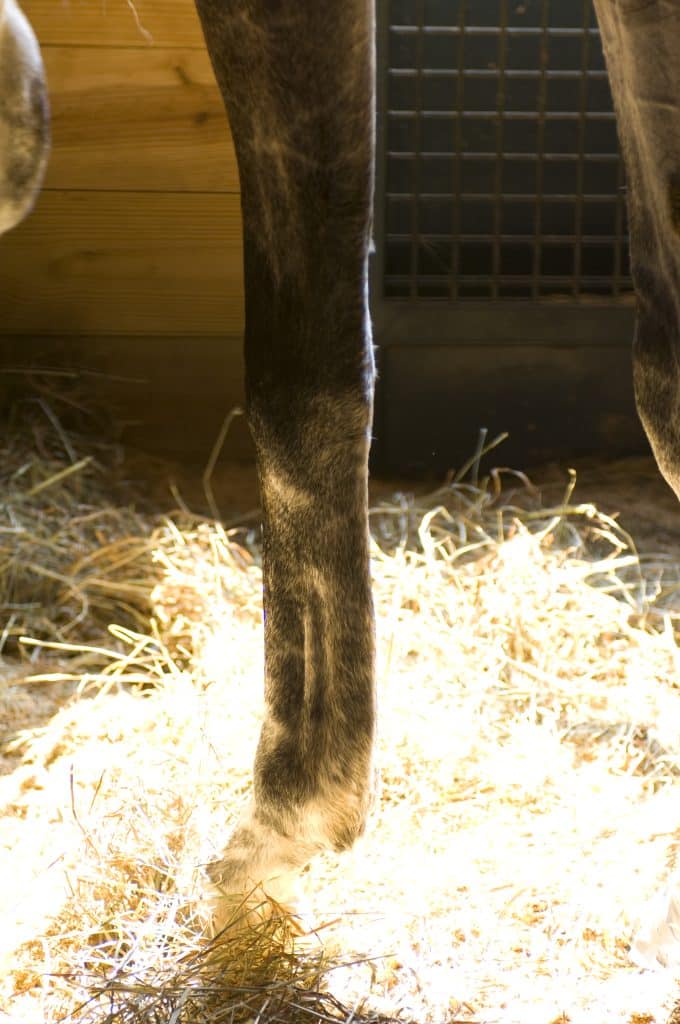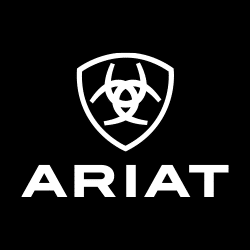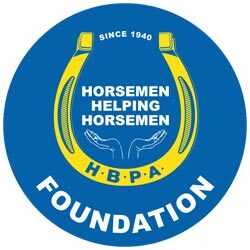
Racing is hard on a Thoroughbred’s joints, but many options exist to protect those joints and help the horse stay sound throughout his life.
Photo by Marc Manning
When purchasing off-track Thoroughbreds for sport, many buyers focus on the condition of the horse’s joints after his racing career. Racing is one of the most demanding sports a horse can undertake, and myriad options exist for both preventing and treating joint problems in racehorses.
Preventative Joint Care for Racehorses
Many products aim to maintain equine joint health with a focus on keeping cartilage healthy. The most effective of these are FDA-approved medications. Veterinarians also use and recommend joint-specific medical devices and feed-through supplements for this purpose.
Adequan IM is polysulfated glycosaminoglycan (PS-GAG). Researchers have shown it to decrease inflammation of the synovial membrane (joint lining) and increase hyaluronic acid levels in the synovial fluid. Hyaluronic acid helps restore joint lubrication. It is given intramuscularly at four-day intervals for seven treatments and repeated every six months as needed.
Legend hyaluronic acid decreases the presence of inflammatory mediators in the joint, improves synovial fluid quality, and reduces the degree of lameness. It is given intravenously at weekly intervals for three treatments and repeated as needed.
Zycosan, pentosan polysulfate sodium, is another injectable drug labeled for osteoarthritis treatment. Its mechanism of action is thought to include stimulation of hyaluronic acid and cartilage structures in damaged joints, inhibition of degrading proteolytic enzymes (enzymes that break down protein) and scavenging of free radicals. It could also affect how cells respond to cytokines, which are messenger proteins that modulate inflammation. It is given intramuscularly at weekly intervals for four weeks.
Examples of common feed-through supplements designed for joint support include Cosequin, Equithrive, and Platinum Performance CJ. These products aim to prevent or slow osteoarthritis progression, although individual results might vary.
Equine Intra-Articular Medications
When any given joint in a horse becomes inflamed or painful, veterinarians might deem it beneficial to inject medication directly into the joint. Historically, veterinarians use corticosteroids most commonly due to their strong anti-inflammatory properties. Corticosteroids they typically use in horses include triamcinolone acetonide (brand names Kenalog or Vetalog), betamethasone sodium phosphate/betamethasone acetate (brand name BetaVet), and methylprednisolone acetate (brand name Depo-Medrol).
Often, the veterinarian adds hyaluronic acid to the steroid injection. This combines the benefit of improving synovial fluid quality with the anti-inflammatory action of the steroid. Common brands include Legend, Hyalovet, Hyvisc and Hylartin V.
While practitioners still use steroids for a large percentage of joint injections, they also utilize “biologic” or “regenerative” therapies such as Pro-Stride APS (autologous — originating from the patient — protein solution) or Orthokine, an IRAP (interleukin-1 receptor antagonist protein, which can be upregulated by autologous conditioned serum from the patient) that help relieve pain and inflammation naturally.
Pro-Stride APS uses the horse’s own blood to yield a concentrated solution of cells, platelets, growth factors and anti-inflammatory cytokines that helps relieve pain in osteoarthritic joints. Interleukin-1 receptor antagonist protein concentrates a specific anti-inflammatory cytokine from the horse’s blood for the same purpose. After processing them, veterinarians inject the resulting regenerative therapy products directly into the joint(s) of interest.
A relatively new class of intra-articular medications, called polyacrylamide hydrogels (PAAGs), use yet a different mechanism to relieve joint pain. Rather than providing an anti-inflammatory effect, these products are designed to either restore joint capsule elasticity and synovial fluid viscosity or create a “cushion” and cartilage lubricant within the joint. Veterinarians have reported these products as very promising treatments in both early and chronic cases of osteoarthritis but do require several weeks to take effect, and horses must be brought back into work gradually for the best results. ArthramidVet and NoltrexVet are the two PAAGs on the market.
Spryng is another hydrogel product derived from collagen and elastin rather than polyacrylamide. Veterinarians might choose to include a steroid with these products at their clinical discretion.
Racehorse Surgical Intervention
Racehorses sometimes sustain training or racing injuries that need surgical repair. Chip fractures within joints — most commonly the carpus (knee) or fetlock (ankle) — heal best when the surgeons remove the fragments promptly and arthroscopically debride the damaged cartilage. Sesamoid fractures can sometimes be surgically repaired; smaller fracture fragments can be removed. Surgeons can effectively repair condylar fractures in the fetlock joint — a break of the cannon bone at the point where it articulates with the long pastern bone — with lag screws. They can repair third carpal bone slab fractures either with lag screws or by removing fragments if they are too small for repair.
When promptly addressed after an injury occurs, Thoroughbred racehorses can often return to their previous level of competition, or at least retire from racing quite sound. Many racehorses have carpal chip fragments removed early in their careers and go on to become winners.
When an injury that should be surgically treated is left without intervention, significant osteoarthritis can result, leading to lameness and loss of function as a racehorse and for a second career.
Racetrack Regulations
The Horseracing Integrity and Safety Authority (HISA), the organization responsible for drafting and enforcing uniform safety and integrity rules in Thoroughbred racing in the United States, strictly regulates medications and intra-articular therapies in horses actively in race training via drug testing as well as stand-down periods following intra-articular injections.
Under HISA rules a horse treated with an intra-articular injection of any joint cannot perform a workout for seven days following treatment or participate in a race for 14 days following treatment. Additional restrictions apply if the horse had a fetlock joint treated with a corticosteroid. He will not be permitted to perform a workout for 14 days following treatment or participate in a race for 30 days following treatment. These regulations are designed to ensure the treatments have time to be effective but, at the same time, are not masking a more serious problem the horse might have.
Due to restrictions on intra-articular therapies in racing, equine practitioners on the track must work closely with the horse’s connections to time treatments for maximum benefit with minimal disruption to the horse’s training and racing schedule. Judicious use of intra-articular therapies can be very beneficial to horses with joints under stress, but connections must be conscious of any underlying conditions that could lead to a catastrophic breakdown if masked by medications. This often means veterinarians perform imaging to ensure no conditions exist that require an extended rest period or require surgery before treatment and resuming training.
Joint Considerations When Evaluating an OTTB for Sport
Keeping horses comfortable while racing helps prevent detrimental compensation patterns in their movement and overuse injuries that can lead to further lameness issues.
Many racehorses receive joint therapies in multiple forms during their careers. Often it can be difficult to ascertain complete histories on horses coming off the track. However, many of these therapies can benefit the horses during their racing years and help them maintain soundness into their second jobs. Regenerative therapies and hydrogels show a lot of promise when used as “early intervention” strategies in appropriate cases. Surgical treatment of joint issues also greatly improves longevity in horses’ second careers, as it can prevent the formation of osteoarthritis secondary to the original injuries.
It is always wise to have a practitioner perform a prepurchase exam on any horse coming straight off the track. Even if a complete veterinary history isn’t available, an exam conducted by a veterinarian knowledgeable about both race and sport horses can be very helpful for identifying active joint issues. Particular attention to the carpi and front fetlocks is important, because these are the most common joints injured and treated in racehorses. Flexion tests might not reliably indicate specific joint problems, but they might help guide imaging choices to identify potential problem areas before purchase.
Take-Home Message
While racing can be stressful on horses’ bodies, these animals’ connections and veterinarians can work closely to keep them moving fluidly and pain-free during their racing careers. Likewise, the thoughtful, judicious use of the medications and technology available today can preserve Thoroughbreds’ soundness for years after they have left the track.
Jennifer Selvig, DVM, is a partner at Cleary Lake Veterinary Hospital, in Prior Lake, Minnesota. She is a member of the CANTER USA Board of Directors and aims to compete at the 2024 Thoroughbred Makeover.










